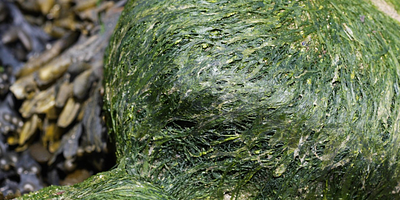
Marine Algae
Though they make their own food through photosynthesis, algae found in the marine environment are different to ‘true’ terrestrial plants. They are much simpler in structure, lacking roots and vascular tissue (tissue that transport water and nutrients around a plant’s body). Instead, water and nutrients simply enter their bodies by diffusion across their surface.
Algae are an incredibly diverse group of organisms, ranging from single-celled microalgae to large seaweeds, or ‘macroalgae’. The giant kelp (Macrocystis pyrifera) in the Pacific Ocean is amongst the largest of the seaweeds, growing to lengths of 50m!
Macroalgae consist of 3 body parts:
- Holdfast – The structure at the base of the seaweed that attaches it to a hard surface. They can be shaped like claws, discs, or simply spread along a rock like a carpet. Unlike plant roots, they do not absorb nutrients.
- Stipe – Similar in function to the stem of plants, this is a trunk-like structure that supports the fronds of the seaweed.
- Fronds – The leaf-like food factories, containing the molecule ‘chlorophyll’ which uses sunlight to convert carbon dioxide and water into sugars.
Different algae survive in different conditions in the marine environment. Some are specially adapted to survive exposure to air twice a day in the ‘intertidal’ zone, whilst others are solely ‘subtidal’, only being suited to life beneath the waves.
Most algae is restricted to the top 50m of the water column to access the light they need for photosynthesis, though some species have been found to absorb the longer, blue wavelengths that reach depths of over 200m.
Algae are incredibly important organisms; they provide the majority of oxygen found in our atmosphere; act as the base of marine foodwebs, supporting huge quantities of life; and are an economically important source of crude oil, food, pharmaceutical and industrial products.
Algaes are classified into 3 groups - the reds, browns, and greens. The colours are caused by the presence (or absence) of pigments associated with the chloroplast molecules, giving their bodies different shades. Colour groups can be misleading though, as some brown-looking seaweeds can actually be from the red group.
Click here for some common seaweeds found on the rocky shores around the UK coastline.
